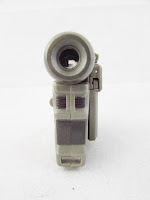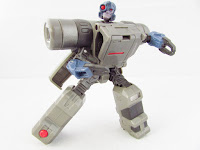If you were under the impression that the Real Gear Robots toyline couldn't possibly get any worse than Speed Dial 800... You'd be about right. However, it's a very close-run thing when it comes to the last few I bought. The funniest thing about the line is that, just 15 or so years later, so many of the alternate modes are so out of date, and Zoom Out 25x is saddled with one such example, along with another of the line's terrible names.
Given that there are already digital (photo) cameras and (ancient-style) cellular telephones available in the line, a camcorder feels like another logical addition. It has as much play value in its alternate mode as in its robot mode, and it's certainly the same kind of consumer technology... But is it a worthwhile addition to this strange and short-lived, movie-adjacent toyline?
It strikes me that the camcorder - at least the digital kind - had a remarkably short lifespan thanks to the swift and sudden advent of mobile phones as jacks-of-all-trades. It used to be that video cameras of all kinds were fairly specialised bits of kit... and the emergence of high-def made them (briefly) all the more specialised. Now, everyone has a camcorder in their pocket, and it's capable of recording in the region of 1920x1080px at the very least, so the very idea of a standalone camcorder has become largely redundant. Not to say they're not still available, and specialised formats like the GoPro are pretty popular for niche markets, but you'd need to have very specific requirements of a video camera if you couldn't make do with a cellphone.
Zoom Out 25X is a very compact model - not necessarily in that it's only intended for the smaller hands of a child, though clearly it is - but fairly realistic in terms of overall design and the specifics of his scant sculpted details. The front of the camera features what could be described as a 'grip' below a couple of grooved and pitted panels suggesting a built-in microphone, as well as a small, translucent panel at the bottom, indicating a built-in lamp. There are shallow-sculpted, silver-painted buttons and what appears to be a latched door - possibly for a memory card of some sort - concealed by the articulated display panel, and then a thumb-operated record button at the back, just below the viewport. The outer face is a bit of a mess, since the robot's head is plainly visible and, while there are another couple of buttons are sculpted onto the hinged panel at the bottom, they are not painted or marked in any way as to their purpose. The barrel of the camera itself is hollow, allowing one to look through the viewfinder at the back, and have a blurry, distorted view of the world in front of the camera. The display panel, in common with other figures in the line, shows the toy's heritage as a delayed Cybertron/Galaxy Force figure rather than a true movie line extension: a sticker featuring Nitro Convoy/Override, albeit with a nod to the movies, in that the time display 07:47 refers to the 4th July release date of the first live action TransFormers movie.
Aside from the immobile, red-painted button at the back and the silver on the main group of buttons, Zoom Out has some gunmetal paint on the lens barrel, a red strip on the sculpted compartment door below the silver buttons, and some darker grey paint on the front 'grip' and mic panels. Aside from that, his only decorations are a Decepticon insignia on the top, just in front of the viewfinder, and his name stamped in black, toward the back, so it's still visible even with the display panel folded down.
His only active play feature is that the display panel can fold up and down, and rotate a full 360°, for the all-important selfies... however, the sticker is upside-down when facing forward, diminishing the effect somewhat. It's a bit of a shame that the record button isn't pushable... it looks like there should have been space to make it a separate, spring-loaded feature, similar to the shutter button on Spyshot 6, but I'd guess the budget on this figure was too low.






Robot Mode:
Well, another Real Gear Robot, another simplistic and ugly robot mode. The exaggerated broadness of the shoulders reminds me of the Kenny Everett character 'General Cheeseburger', and the way some of the camera panels fold up to form his chest leaves a gaping hole in his body, plainly visible from the sides. The arms are handled very strangely, with the rotation joint being part of the camera's main barrel, but then outward movement is handled by a pinned joint immediately below, giving the effect of a slightly shorter robot wearing an excessively-shouldered costume accessory.
Like most of his contemporaries, there's not a great deal of sculpted detail on display in robot mode. The arms and thighs are the only parts unique to this mode, and they're all fairly simplistic. It is interesting to note that his claws, while not mobile, are serrated on the insides, but the other limb detailing is pretty perfunctory and the forearms are partially hollow. What's really strange is that the majority of the sculpted detail on this figure is simply not visible... because it's on the inner faces of his larger panels. For example, lift up the chest panel, and details reminiscent of the G1 TV show's animation model for Reflector become visible, along with an element that looks almost like a watch battery, held in place by a clip, along with some random pipework. The inside of the raised panel only really looks like shallow armour detailing, and is nothing special. Perhaps the craziest feature, though, is the digital display panel's role in his robot mode. Not content with being a mere cape, like on Speed Dial 800, the panel actually splits open to become a pair of wings on some kind of directable jet pack. The back panel essentially remains as a cape, albeit a nicely detailed cape, even if the details are a little vague as to their purpose. The detailing on the insides of the wings looks like barely embellished structural support for the most part, but it's also somewhat reminiscent of the stickers on G1 Buzzsaw/Laserbeak's wings. The overall effect is almost like Zoom Out is wearing a legless beetle on his back. None of this more elaborate detailing is painted, but that should come as no surprise considering it's all hidden from view.
It seems to me that the head sculpt is a little reminiscent of a Megatron, but with elements of the Borg from Star Trek. It's almost as if the traditional 'bucket-head' helmet was stripped open, and implants - most notably the enlarged optical sensor on the righthand side - were grafted in. The expression is very on-brand for both Megatron and the Borg, so it's really only the colourscheme that stands out as anything unusual. A pale, desaturated blue helmet coupled with a pale, desaturated purple face isn't the most intuitive choice and either the purple paint is very heavy, it's been applied over the top of the pale blue, or the sculpt around the mouth just isn't that sharp. The cheekbones and jutting chin are suitably pronounced, but the mouth is barely there. The enlarged optic seems offset from where I'd expect it to be, given the position of the normal eye, but I guess it's not intended for the sort of binocular vision humans enjoy... and I quite like the asymmetry of it.









Aside from the wraparound chest panels, much of Zoom Out's transformation is not dissimilar to the likes of G1 Rumble/Frenzy or Speed Dial 800. It's fairly obvious that the asymmetrical legs simply fold up around the robot's sides - the camera's front and back - with the arms tucking in (somewhat awkwardly) thanks to a groove on the inside of the knees. In all honesty, it might have been simpler and more reliable to just make the claws shorter. The remainder of the transformation is unfurling the chest, tucking the head in at the front, and then folding the chest panels back around his pelvis to close off the bottom of the camera. It's all very simple, and the only sticking point is getting the forearms into position to be enclosed by the lower legs.
I've already mentioned the curious articulation of the arms, but it's worth adding that the cape is marginally wider than the inner edge of the shoulder rotation, meaning it has to be finagled out of the way to permit any backward movement. Initially, I thought there was a stopping point for the rotation, since the joint seemed to stop firmly at a specific point, regardless of whether the arms were rotated forward or back, but it is just the cape getting in the way. The hinge allows the arms to swing out by about 90°, then the ball-jointed elbow offers 90° bend and has to fill in for the lack of bicep rotation. There's no waist rotation, but the hips can kick forward, back and out to the sides through a little more than 90°. Due to transformation, he has a rotation joint a little bit above the knee, and then the knee itself can bend to about 135°. Naturally, there are no ankle joints, but he's reasonably stable even in some quite dynamic poses, despite generally standing on the inner edges of the 'feet'. The head is on a ball joint, supplemented by the transformation joint, which allows him to tilt his head back slightly (a small tab on the back butts up against the cape, but it can be forced further, such that the back of his head hits the cape) and forward until it hits his chest. The ball joint itself allows 360° rotation, and a small amount of tilt in any direction.
In a lot of ways, Zoom Out 25X is little more than a marginal improvement on Speed Dial 800 in terms of his engineering, The transformation is remarkably similar, but his device mode is slightly more interesting, and his robot mode far more dynamic and stable. That said, Speed Dial 800 is easily the lowest point in the Real Gear Robots toyline, so that's not exactly a recommendation. There's still a sense that Zoom Out could have been better, and making him slightly larger could have facilitated this. As TransFormers video cameras go, Armada Laserbeak has proven to be a difficult figure to top, but it's fairly clear that, even if Real Gear Robots was originally intended to be parallel to the Unicron Trilogy, none of them could have competed with the earlier, larger-format Laserbeak with his spring-loaded and battery-operated play features.

No comments:
Post a Comment